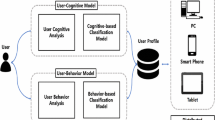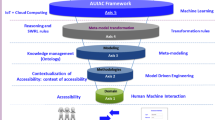Abstract
Personalized services have greater impact on user experience to effect the level of user satisfaction. Many approaches provide personalized services in the form of an adaptive user interface. The focus of these approaches is limited to specific domains rather than a generalized approach applicable to every domain. In this paper, we proposed a domain and device-independent model-based adaptive user interfacing methodology. Unlike state-of-the-art approaches, the proposed methodology is dependent on the evaluation of user context and user experience (UX). The proposed methodology is implemented as an adaptive UI/UX authoring (A-UI/UX-A) tool; a system capable of adapting user interface based on the utilization of contextual factors, such as user disabilities, environmental factors (e.g. light level, noise level, and location) and device use, at runtime using the adaptation rules devised for rendering the adapted interface. To validate effectiveness of the proposed A-UI/UX-A tool and methodology, user-centric and statistical evaluation methods are used. The results show that the proposed methodology outperforms the existing approaches in adapting user interfaces by utilizing the users context and experience.










Similar content being viewed by others
References
Ahmad M, Amin MB, Hussain S, Kang BH, Cheong T, Lee S (2016) Health fog: a novel framework for health and wellness applications. J Supercomput 72(10):3677–3695
Akiki PA, Bandara AK, Yu Y (2014) Adaptive model-driven user interface development systems. ACM Comput Surv CSUR 47(1):9
Akiki PA, Bandara AK, Yu Y (2016) Engineering adaptive model-driven user interfaces. IEEE Trans Softw Eng 42(12):1118–1147
Ali R, Afzal M, Hussain M, Ali M, Siddiqi MH, Lee S, Kang BH (2016) Multimodal hybrid reasoning methodology for personalized wellbeing services. Comput Biol Med 69:10–28
Ali T, Lee S (2016) Wellness concepts model use and effectiveness in intelligent knowledge authoring environment. In: International conference on smart homes and health telematics. Springer, pp 271–282
Amin MB, Banos O, Khan WA, Muhammad Bilal HS, Gong J, Bui DM, Cho SH, Hussain S, Ali T, Akhtar U et al (2016) On curating multimodal sensory data for health and wellness platforms. Sensors 16(7):980
Balme L, Demeure A, Barralon N, Coutaz J, Calvary G (2004) Cameleon-rt: a software architecture reference model for distributed, migratable, and plastic user interfaces. In: European symposium on ambient intelligence. Springer, pp 291–302
Banos O, Bilal Amin M, Ali Khan W, Afzal M, Hussain M, Kang BH, Lee S (2016) The mining minds digital health and wellness framework. Biomed Eng Online 15(1):165–186. https://doi.org/10.1186/s12938-016-0179-9
Banos O, Bilal-Amin M, Ali-Khan W, Afzel M, Ahmad M, Ali M, Ali T, Ali R, Bilal M, Han M, Hussain J, Hussain M, Hussain S, Hur TH, Bang JH, Huynh-The T, Idris M, Kang DW, Park SB, Siddiqui M, Vui LB, Fahim M, Khattak AM, Kang BH, Lee S (2015) An innovative platform for person-centric health and wellness support. In: Proceedings of the international work-conference on bioinformatics and biomedical engineering (IWBBIO 2015)
Banos O, Bilal-Amin M, Ali-Khan W, Afzel M, Ali T, Kang BH, Lee S (2015) The mining minds platform: a novel person-centered digital health and wellness framework. In: Proceedings of the 9th international conference on pervasive computing technologies for healthcare (PervasiveHealth 2015)
Banos O, Villalonga C, Bang JH, Hur TH, Kang D, Park SB, Hyunh-The T, Vui LB, Amin MB, Razzaq MA, Ali Khan W, Hong CS, Lee S (2016) Human behavior analysis by means of multimodal context mining. Sensors 16(8):1–19
Blouin A, Beaudoux O (2010) Improving modularity and usability of interactive systems with malai. In: Proceedings of the 2nd ACM SIGCHI symposium on engineering interactive computing systems. ACM, pp 115–124
Brooke J et al (1996) Sus: a quick and dirty usability scale. Usability Eval Ind 189(194):4–7
Calvary G, Coutaz J, Thevenin D, Limbourg Q, Bouillon L, Vanderdonckt J (2003) A unifying reference framework for multi-target user interfaces. Interact Comput 15(3):289–308
Castillejo E, Almeida A, López-de Ipiña D (2014) Ontology-based model for supporting dynamic and adaptive user interfaces. Int J Hum Comput Interact 30(10):771–786
Chu H, Song H, Wong C, Kurakake S, Katagiri M (2004) Roam, a seamless application framework. J Syst Softw 69(3):209–226
Coutaz J (2010) User interface plasticity: Model driven engineering to the limit! In: Proceedings of the 2nd ACM SIGCHI symposium on engineering interactive computing systems. ACM, pp 1–8
Daniel AO, Yinka A, Frank I, Adesina S (2013) Culture-based adaptive web design Int J Sci Eng Res 4(2)
Gajos KZ, Weld DS, Wobbrock JO (2010) Automatically generating personalized user interfaces with supple. Artif Intell 174(12):910–950
Gamecho B, Minón R, Aizpurua A, Cearreta I, Arrue M, Garay-Vitoria N, Abascal J (2015) Automatic generation of tailored accessible user interfaces for ubiquitous services. IEEE Trans Hum Mach Syst 45(5):612–623
Ghiani G, Manca M, Paternò F (2015) Authoring context-dependent cross-device user interfaces based on trigger/action rules. In: Proceedings of the 14th international conference on mobile and ubiquitous multimedia. ACM, pp 313–322
Ghiani G, Manca M, Paternò F, Santoro C (2017) Personalization of context-dependent applications through trigger-action rules. ACM Trans Comput Hum Interact TOCHI 24(2):14
Guerrero-Garcia J, Gonzalez-Calleros JM, Vanderdonckt J, Munoz-Arteaga J (2009) A theoretical survey of user interface description languages: preliminary results. In: Web congress, 2009. LA-WEB’09. Latin American. IEEE, pp 36–43
Heckmann D, Schwartz T, Brandherm B, Schmitz M, von Wilamowitz-Moellendorff M (2005) GUMO—the general user model ontology. In: International conference on user modeling. Springer, pp 428–432
Helms J, Schaefer R, Luyten K, Vermeulen J, Abrams M, Coyette A, Vanderdonckt J (2009) Human-centered engineering of interactive systems with the user interface markup language. Hum Cent Softw Eng 139–171. https://doi.org/10.1007/978-1-84800-907-3_7
Hussain J, Khan WA, Afzal M, Hussain M, Kang BH, Lee S (2014) Adaptive user interface and user experience based authoring tool for recommendation systems. In: International conference on ubiquitous computing and ambient intelligence. Springer, pp 136–142
Jorritsma W, Cnossen F, van Ooijen PM (2015) Adaptive support for user interface customization: a study in radiology. Int J Hum Comput Stud 77:1–9
Langley P (1997) Machine learning for adaptive user interfaces. In: Annual conference on artificial intelligence. Springer, pp 53–62
Laugwitz B, Held T, Schrepp M (2008) Construction and evaluation of a user experience questionnaire. In: Symposium of the Austrian HCI and usability engineering group. Springer, pp 63–76
Law ELC, van Schaik P (2010) Modelling user experience-an agenda for research and practice. Interact Comput 22(5):313–322
Lehmann G, Rieger A, Blumendorf M, Albayrak S (2010) A 3-layer architecture for smart environment models. In: 2010 8th IEEE international conference on pervasive computing and communications workshops (PERCOM workshops). IEEE, pp 636–641
Limbourg Q, Vanderdonckt J, Michotte B, Bouillon L, López-Jaquero V (2004) USIXML: a language supporting multi-path development of user interfaces. In: International workshop on design, specification, and verification of interactive systems. Springer, pp 200–220
Meixner G, Paterno F, Vanderdonckt J (2011) Past, present, and future of model-based user interface development. i-com 10(3):2–11
Mezhoudi N, Khaddam I, Vanderdonckt J (2015) Wisel: a mixed initiative approach for widget selection. In: Proceedings of the 2015 conference on research in adaptive and convergent systems. ACM, pp 349–356
Michotte B, Vanderdonckt J (2008) GrafiXML, a multi-target user interface builder based on Usixml. In: Fourth international conference on autonomic and autonomous systems (ICAS’08), pp 15–22. https://doi.org/10.1109/ICAS.2008.29
Miñón R, Paternò F, Arrue M (2013) An environment for designing and sharing adaptation rules for accessible applications. In: Proceedings of the 5th ACM SIGCHI symposium on engineering interactive computing systems. ACM, pp 43–48
Mori G, Paternò F, Santoro C (2002) CTTE: support for developing and analyzing task models for interactive system design. IEEE Trans Softw Eng 28(8):797–813
Motti VG, Vanderdonckt J (2013) A computational framework for context-aware adaptation of user interfaces. In: 2013 IEEE seventh international conference on research challenges in information science (RCIS). IEEE, pp 1–12
Norman KL, Shneiderman B, Harper B, Slaughter L (1998) Questionnaire for user interaction satisfaction. University of Maryland (Norman, 1989) Disponível em
Paternò F, Santoro C (2003) A unified method for designing interactive systems adaptable to mobile and stationary platforms. Interact Comput 15(3):349–366
Paterno F, Santoro C, Spano LD (2009) Maria: a universal, declarative, multiple abstraction-level language for service-oriented applications in ubiquitous environments. ACM Trans Comput Hum Interact TOCHI 16(4):19
Peissner M, Häbe D, Janssen D, Sellner T (2012) MyUI: generating accessible user interfaces from multimodal design patterns. In: Proceedings of the 4th ACM SIGCHI symposium on engineering interactive computing systems. ACM, pp 81–90
Surguy M (2013) History of Laravel PHP framework, Eloquence emerging. Maxoffsky. http://maxoffsky.com/codeblog/history-of-laravel-php-framework-eloquence-emerging
Viana W, Andrade RM (2008) XMobile: a MB-UID environment for semi-automatic generation of adaptive applications for mobile devices. J Syst Softw 81(3):382–394
Villalonga C, Banos O, Khan WA, Ali T, Razzaq MA, Lee S, Pomares H, Rojas I (2015) High-level context inference for human behavior identification. In: International workshop on ambient assisted living. Springer, pp 164–175
Acknowledgements
This work was supported by the Industrial Core Technology Development Program (10049079, Develop of mining core technology exploiting personal big data) funded by the Ministry of Trade, Industry and Energy (MOTIE, Korea). This work was supported by the MSIT (Ministry of Science and ICT), Korea, under the ITRC (Information Technology Research Center) support program (IITP-2017-0-01629) supervised by the IITP (Institute for Information & communications Technology Promotion). This work was supported by Institute for Information & communications Technology Promotion (IITP) grant funded by the Korea government (MSIT) (No. 2017-0-00655) and NRF-2016K1A3A7A03951968.
Author information
Authors and Affiliations
Corresponding author
Rights and permissions
About this article
Cite this article
Hussain, J., Ul Hassan, A., Muhammad Bilal, H.S. et al. Model-based adaptive user interface based on context and user experience evaluation. J Multimodal User Interfaces 12, 1–16 (2018). https://doi.org/10.1007/s12193-018-0258-2
Received:
Accepted:
Published:
Issue Date:
DOI: https://doi.org/10.1007/s12193-018-0258-2




